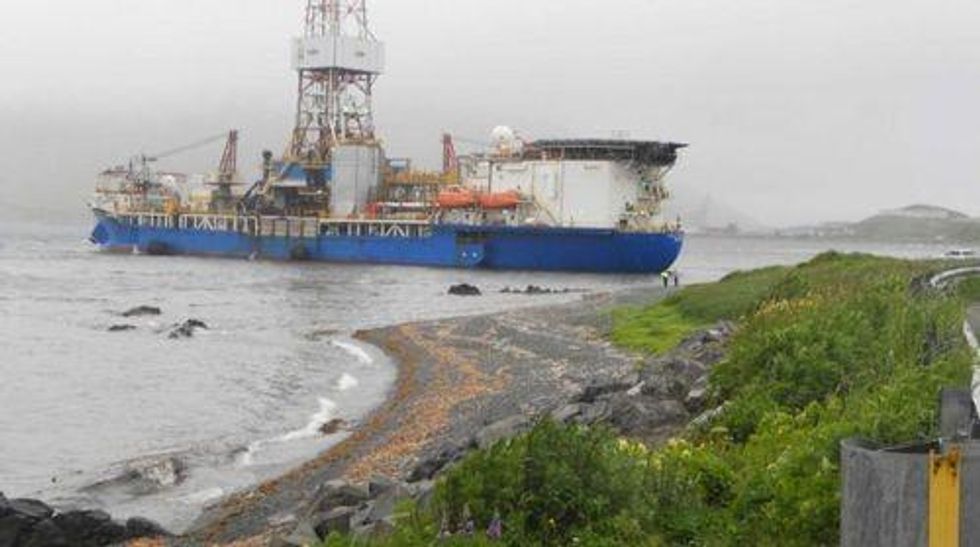Shell Oil announced it will suspend its Arctic Ocean drilling program until at least 2014. But it turns out that after you ground a drilling rig, leak oil into the water, and crush your emergency response equipment, you don't get to decide when you return.
Then-Secretary of the Interior Ken Salazar recently said, "Shell will not be allowed to move forward into the Arctic to do any kind of exploration unless they have this integrated plan in place that's satisfactory to the Department of the Interior."
The reasoning behind this firm stance is clear: "Shell screwed up in 2012," the secretary said.
Indeed, Shell did have an astonishing string of failures and fiascos last year. But the truth is no company will prove a match for the forbidding Arctic environment. Other oil giants have been watching Shell's misadventures and are starting to second guess their own future in the region.
Norway's Statoil, for instance, recently said it was postponing plans to drill in the American Arctic until 2015 at the very earliest. The company is already drilling in Norwegian Arctic waters of the Barents Sea, where it does not freeze, is close to infrastructure and has more hospitable weather due to the Gulf Stream.
The American Arctic is different. It is covered by ice most of the year and dominated by extreme cold, hurricane-strength storms, pervasive fog, and long periods of darkness. These obstacles prompted Total SA, the fifth largest oil and gas company in the world, to declare it wouldn't seek to drill in the Arctic because an accident there would be a "disaster." German bank WestLB also announced that it would refuse financing to any offshore oil and gas drilling in the region because "the risks and cost are simply too high."
Some of those risks were on display during Shell's ill-fated effort last year. Twenty-four hours after Shell started preliminary drilling early last September its drill rig, the Noble Discoverer, had to turn tail and flee from a 30-mile long iceberg covering 360 square miles of water. In December, a routine winter storm caused Shell's other drill rig, the Kulluk, to run aground near Alaska's Kodiak Island on its way to Seattle for maintenance.
If a major spill had occurred, it is clear Shell wasn't prepared to respond. The company's emergency response barge--a linchpin of its spill response strategy--was stuck in Bellingham, Washington throughout the drilling season because it kept violating standards for safety, air pollution, and other critical measures. Meanwhile, the containment dome the company was supposed to use to capture oil in the event of spill was "crushed like a beer can" during pre-deployment testing.
There is no backup in the American Arctic when systems fail. The Coast Guard oversees spill response, yet the closest Coast Guard base is 1,000 miles away. Two of the Coast Guards polar icebreaking vessels are not even operational, leaving them with only one. There are few shipping ports or landing strips near the lease sites. Bringing rescue crews and clean up equipment to the Arctic environment would be a staggering challenge.
And even if we could get them there, the region is covered in ice for over eight months a year, and no proven technology has been able to clean up oil in icy waters.
Yet Shell dove right into these treacherous conditions. The company's subsequent failures prompted the Department of Interior to conduct an urgent, 60-day review of Shell's operations in the Arctic. The report, released a few weeks ago, described the dangers of drilling in the region and the "catastrophic consequences" a spill would have on the Arctic's fragile ecosystems and the people who depend upon them for livelihoods and cultural traditions.
Now it's time for the Obama Administration to put this risky and dangerous drilling on hold immediately. It should not make any new decisions until it has completed a more thorough review of all drilling operations in the Arctic. Nominee for Secretary of the Interior Sally Jewell should prioritize this and ensure the Interior Department does not make the same mistakes again. Shell's track record reveals the dangers of reckless action in the Arctic.
We must protect this wild ocean before a major disaster occurs. Click here to tell the Obama Administration to stop Shell's reckless Arctic offshore scheme.

